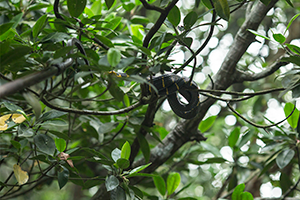 The two snakes that clung to the mangrove tangle over the narrow inlet were what you might call double-trouble. The larger one was black and ringed in yellow, the smaller one bright green. The former one the locals call Ular Tiong – the Gold-Ringed Cat Snake. The latter, most likely a White-Lipped Tree Viper. Both are poisonous.
The two snakes that clung to the mangrove tangle over the narrow inlet were what you might call double-trouble. The larger one was black and ringed in yellow, the smaller one bright green. The former one the locals call Ular Tiong – the Gold-Ringed Cat Snake. The latter, most likely a White-Lipped Tree Viper. Both are poisonous.
As our pilot boat went ahead, led by Wai Yin Yap, our intrepid local AD, he shouted back to us that we could not go any further with our cast and crew boats until the snakes were removed. To continue along the narrow gantlet would mean our three small boats – camera, crew, and starring cast – passing directly beneath the snakes as they slept in all their iridescent, cytotoxic glory.
We would need to wait for the snakes to be removed.
But the challenging thing about shooting on the Sungai Lebam is that it’s a coastal tidal river that flows with the rising tide of the South China Sea. Waiting is a problem. Racing the clock is always an issue in the run-andgun system of shooting a TV series, but racing low tide makes it tougher. Every second counts if we’re going to make our day.
As locals in the pilot boat used oars and pike poles to try to dislodge the snakes ( a lot of yelling and screaming in Malay), we all lingered in our boats some thirty yards back. After five minutes, the green viper came loose and hit the water, disappeared. But ol’ Ular Tiong, the big Gold- Ringed Cat Snake refused to give up his tree.
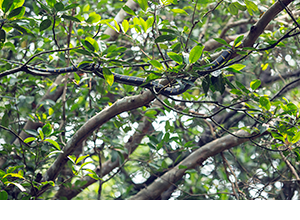 With the tides against us (literally) I made an executive producer decision to leave the snake where he was and just get the shot. Director-Producer Dan Minahan, focused on the camera angles and directing the actors, agreed. First AD Sean Guest radioed to the pilot boat and they quickly moved out of sight, opening the path for us to continue on, towing the cast in a period skiff directly beneath the snake. Roll sound.
With the tides against us (literally) I made an executive producer decision to leave the snake where he was and just get the shot. Director-Producer Dan Minahan, focused on the camera angles and directing the actors, agreed. First AD Sean Guest radioed to the pilot boat and they quickly moved out of sight, opening the path for us to continue on, towing the cast in a period skiff directly beneath the snake. Roll sound.
It wasn’t a one-take deal. We passed slowly and deliberately, upriver and back downriver, under that spectacular-looking mangrove snake perhaps ten times. I admire our actors who stayed in character on every take, even when they could see that poisonous reptile draped precariously just above them.
I’ve said it before on this blog and I’ll say it again: We’re not just making Marco Polo, we’re living it.
***
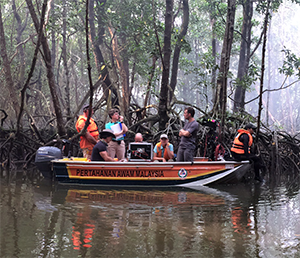 The Sungai Lebam, brackish and brooding and banked by otherworldly mangrove trees, is a river that Joseph Conrad would respect. As you depart the base camp and pass the last kelongs (rickety off-shore huts) you motor your way up estuarine waters teeming with sea bass, grouper, snapper, flying fish, and sting rays. There have been reports in the not-so-distant past of very small remnant populations of dugongs (those large manatee relatives).
The Sungai Lebam, brackish and brooding and banked by otherworldly mangrove trees, is a river that Joseph Conrad would respect. As you depart the base camp and pass the last kelongs (rickety off-shore huts) you motor your way up estuarine waters teeming with sea bass, grouper, snapper, flying fish, and sting rays. There have been reports in the not-so-distant past of very small remnant populations of dugongs (those large manatee relatives).
Campbell Mitchell, a true pro on our Standby Props squad, gamely navigated the river and mangrove tangles in an impossibly small red craft called a Titan Genesis, a minikayak. As the Scotsman handled props at surface-level on the river, he told me he encountered some “spitting fish” that he saw spit at insects on the overhanging branches, knocking them into the river so they could feed. These fish, known as the ‘Archer’ Fish are said to be able to nail a target with a jet of spit at an impressive distance. There are times, in places like this, when you feel like you’re on the fictional Pandora in Avatar.
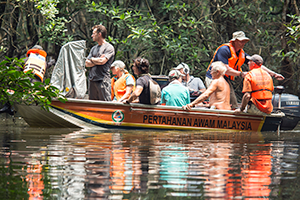 Two species of monkeys own the jungle here: The long-tailed macaque and the rare Silvery Lutung (classed as Near Threatened). Both are mostly unseen all day. But when the tide drops, the macaque converge in troops down to river’s edge to catch crabs and put on a great show for our crew. On our first day they came down to investigate our VFX balloons and decided to run away into the jungle with a few of the strays as if they scored something special. One of our crew heard a POP deep in the vines and some subsequent angry chatter. “I don’t think monkeys have a sense of humor,” he said.
Two species of monkeys own the jungle here: The long-tailed macaque and the rare Silvery Lutung (classed as Near Threatened). Both are mostly unseen all day. But when the tide drops, the macaque converge in troops down to river’s edge to catch crabs and put on a great show for our crew. On our first day they came down to investigate our VFX balloons and decided to run away into the jungle with a few of the strays as if they scored something special. One of our crew heard a POP deep in the vines and some subsequent angry chatter. “I don’t think monkeys have a sense of humor,” he said.
All my life I’ve wanted to see monkey troops in the wild. So it was a personal thrill to watch these long-tailed macaques run along mangroves or sit up and stare back at us. Our brilliant French cinematographer, Romain Lacourbas, actually got them in the background of a shot at one point, but the low tide caught us just then and derailed the scene when the boat grounded out.
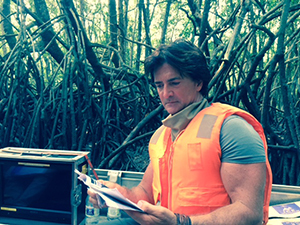 Moments before that, the mangroves grabbed at Steve De Rocco, our First Assistant Camera, and literally pulled him off the boat. Crew members shoved at vines and branches and muddy roots covered in sharp barnacles as Steve, young and fit, wrestled himself out of the hold and back to his camera like nothing happened. At the bend of that same stretch a certain writer-producer did a martial arts jump off the boat, launching for the shore (to find a tree) – and made it. Only to immediately sink up to his quads in bank silt like quicksand. Two admissions: 1) It was me. 2) Finding that tree was worth it.
Moments before that, the mangroves grabbed at Steve De Rocco, our First Assistant Camera, and literally pulled him off the boat. Crew members shoved at vines and branches and muddy roots covered in sharp barnacles as Steve, young and fit, wrestled himself out of the hold and back to his camera like nothing happened. At the bend of that same stretch a certain writer-producer did a martial arts jump off the boat, launching for the shore (to find a tree) – and made it. Only to immediately sink up to his quads in bank silt like quicksand. Two admissions: 1) It was me. 2) Finding that tree was worth it.
Meanwhile, after returning to the mothership to re-rig the camera boat for the next shot, that Gold-Ringed Cat Snake hadn’t budged an inch. Again, we began repeated slow passes right beneath him. Believe me, it never got old and you could see the respect on the faces of all. Kind of like quietly trespassing on the property of a man asleep on the porch with a loaded shotgun on his lap.
Only 17 of the 105 land snakes in Malaysia are venomous. Among them, the king cobra, spitting cobra, Sumatran pit viper, and red-headed krait. Regarding the water snakes: All 14 species of fresh water snakes are harmless but all 22 species of sea snakes are venomous. So when you’re entering estuarine waters, open to the sea, all bets are off.
Which begs the question as we boat our way up the murky river like Martin Sheen, looking for Colonel Kurtz: what other exotic reptilian secrets does this brackish water hold?
Forty-five minutes into our first day on the water, Sean Guest and I spotted a saltwater crocodile crossing the river far out ahead of us, that classic profile of eyes periscoping above the surface as it glided soundlessly.
The Malaysian guide who took our scouting party upriver a few weeks back said that the crocs in this particular river don’t come around much and “don’t get naughty.” Years back, while doing research with federal wildlife officers in the Everglades, I never came across anything on well-behaved crocodiles, but I want to believe that’s true — for the next 2 days any way.
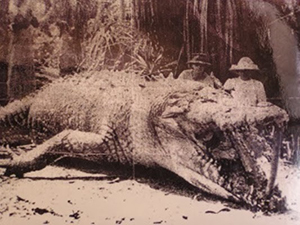 Honestly, I did not know that saltwater crocs remained extant in these parts. Long extinct in China, Thailand, and Cambodia, I didn’t think there were breeding populations left in Peninsular Malaysia. The fact is, not only do a good many survive here, but a few have even become local legend. Like a massive croc that terrorized the Lupar River in Sarawak beginning in 1941, a man-eater known as ‘Bujang Senang.’ The name means ‘Happy Bachelor’ and local lore holds that he was reincarnated from a human warrior whose wife betrayed him by getting horny with his foes and one day ambushing and beheading him. His vengeful spirit manifested as a huge crocodile and went on a rampage up and down the river.
Honestly, I did not know that saltwater crocs remained extant in these parts. Long extinct in China, Thailand, and Cambodia, I didn’t think there were breeding populations left in Peninsular Malaysia. The fact is, not only do a good many survive here, but a few have even become local legend. Like a massive croc that terrorized the Lupar River in Sarawak beginning in 1941, a man-eater known as ‘Bujang Senang.’ The name means ‘Happy Bachelor’ and local lore holds that he was reincarnated from a human warrior whose wife betrayed him by getting horny with his foes and one day ambushing and beheading him. His vengeful spirit manifested as a huge crocodile and went on a rampage up and down the river.
It is said that Bujang Senang killed more than 20 people over the course of 50 years and could not be caught. In 1992, the ‘Happy Bachelor’ was believed to have reappeared on the Lupar River when a 30 year-old woman was snatched. The enormous crocodile was hunted down by a posse of 25 locals and driven toward a river trap made of wood and bamboo. It reportedly smashed through the fence, but was eventually caught and killed by repeated gunfire. At least one report I dug up says grenades were used to finally stop it.
Bujang Senang. Whatever spirit moved him, that was one bad-ass crocodile.
So this, my friends, is no Blue Danube. And how many chances in life do we get to travel to places like this and capture the soul of the land, the drama and magic of our story world? Season one took us to the canals of Venice, the Kazakh steppe, and Southeast Asia. Season two has so far taken us (after prep trips to China and Mongolia) to Hungary (the Blue Danube actually, and magnificent hill forests), the Carpathian Mountains of Slovakia, and again, back here in Malaysia and exotic locations like these rich jungle wetlands.
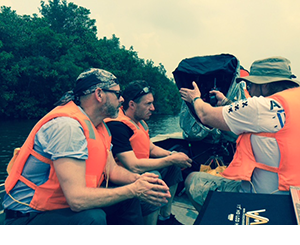 At the end of the day, it’s all about putting on the screen, the epic scope Marco Polo’s story and mythology deserves – and what the show’s fans deserve. But it couldn’t be done without a cast, crew, and creative team who all have some Marco Polo in them. You have to, if you’re going to sign up for this caravan life- and follow the Silk Road or the Sungai Lebam.
At the end of the day, it’s all about putting on the screen, the epic scope Marco Polo’s story and mythology deserves – and what the show’s fans deserve. But it couldn’t be done without a cast, crew, and creative team who all have some Marco Polo in them. You have to, if you’re going to sign up for this caravan life- and follow the Silk Road or the Sungai Lebam.
I woke up to an email from director Dan Minahan who, despite the challenges, got every shot on his storyboards, and then some. “Boats, monkeys, swamp, snakes, crocs, broken oars, people falling in, boats adrift, that was actually really fun to shoot.”









